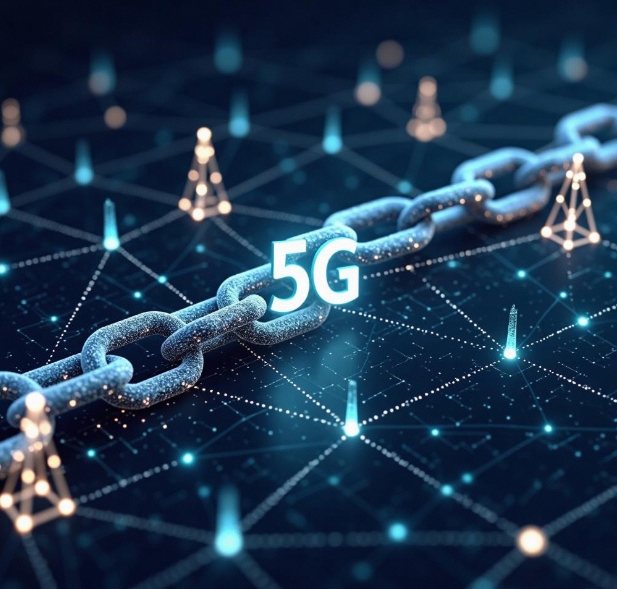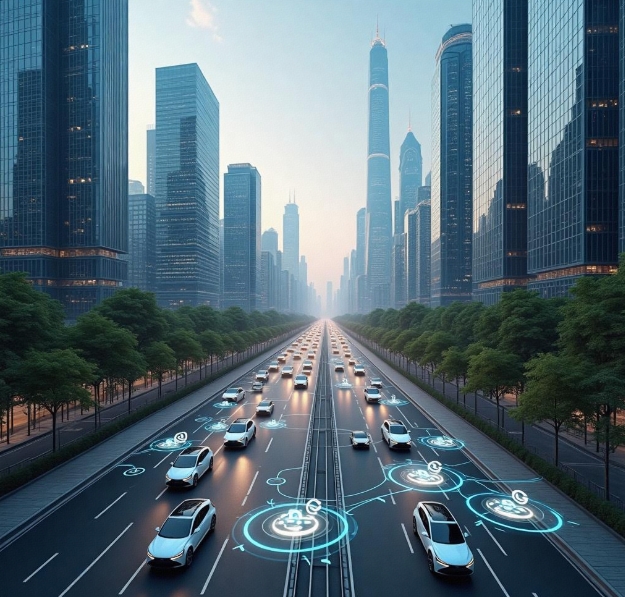Blockchain and 5G Integration: Accelerating Innovation in Decentralized Applications
- latest articles
- 1.DApp Development & Customization: Merging Diverse Market Needs with User Experience 2.Analysis of the Core Technical System in DApp Project Development 3.How to achieve cross-chain interoperability in Web3 projects? 4.How does the tokenization of points reconstruct the e-commerce ecosystem? 5.How to Set and Track Data Metrics for a Points Mall? 6.What is DApp Development? Core Concepts and Technical Analysis 7.Inventory of commonly used Web3 development tools and usage tips 8.Development of a Distribution System Integrated with Social E-commerce 9.Six Key Steps for Businesses to Build a Points Mall System 10.What is DApp Development? A Comprehensive Guide from Concept to Implementation
- Popular Articles
- 1.Future Trends and Technology Predictions for APP Development in 2025 2.Analysis of the DeFi Ecosystem: How Developers Can Participate in Decentralized Finance Innovation 3.From Zero to One: How PI Mall Revolutionizes the Traditional E-commerce Model 4.DAPP Development | Best Practices for Professional Customization and Rapid Launch 5.Recommended by the Web3 developer community: the most noteworthy forums and resources 6.From Cloud Computing to Computing Power Leasing: Building a Flexible and Scalable Computing Resource Platform 7.How to Develop a Successful Douyin Mini Program: Technical Architecture and Best Practices 8.Shared Bike System APP: The Convenient Choice in the Era of Smart Travel 9.How to Create a Successful Dating App: From Needs Analysis to User Experience Design 10.From Design to Development: The Complete Process of Bringing an APP Idea to Life
With the rapid advancement of technology, blockchain and 5G technologies have become key forces driving innovation in the digital era. Blockchain, as a decentralized distributed ledger technology, is profoundly influencing data storage, transactions, and information processing across various industries due to its characteristics of decentralization, security, and transparency. Meanwhile, 5G technology, as the next generation of wireless communication, is bringing unprecedented network experiences globally with its high speed, low latency, and extensive coverage.
When blockchain and 5G technologies are combined, their complementary advantages will create more innovative decentralized applications, promote the development of the digital economy, and ultimately transform how people produce, live, and interact. This article will delve into the potential of integrating blockchain with 5G technology and how this combination can accelerate the innovation of decentralized applications.
1. Overview of Blockchain and 5G Technology
1.1 Basic Principles of Blockchain Technology
Blockchain is a distributed ledger technology that divides data into multiple "blocks" in chronological order and links these blocks together through cryptographic algorithms to form an immutable chain. Each block contains multiple transaction records, and all participants in the blockchain network can access, verify, and update these records, ensuring data transparency, security, and integrity.
Decentralization is one of the core features of blockchain technology. It does not rely on any central authority or intermediary but achieves consensus through mechanisms among nodes in the network. This characteristic gives blockchain broad application prospects in fields such as finance, supply chain, and the Internet of Things.
1.2 Characteristics of 5G Technology
5G technology is the fifth generation of wireless communication. Compared to 4G, 5G offers higher transmission speeds, lower latency, and stronger connectivity. 5G can achieve download speeds of up to 10 Gbps, with latency as low as 1 millisecond, and supports connections for a massive number of devices, making the Internet of Everything possible.
The advantages of 5G lie in its ultra-high bandwidth, ultra-low latency, and high reliability, providing a solid foundation for the development of technologies such as the Internet of Things, big data analytics, and artificial intelligence. Its role is particularly prominent in areas like smart cities, autonomous driving, and smart manufacturing.
2. The Necessity of Combining Blockchain and 5G Technology
2.1 Growing Demand for Decentralized Applications
With the advancement of digital transformation, traditional centralized systems face numerous challenges, such as data security, privacy protection, and inefficiency. Decentralized applications (DApps), as innovative applications based on blockchain, can effectively address these issues by providing more secure, transparent, and efficient services.
However, the widespread adoption of decentralized applications also faces challenges. First, while blockchain technology offers decentralized data storage and transaction methods, bottlenecks still exist in data transmission and network connectivity. Second, decentralized applications require extensive real-time data exchange and high bandwidth support, placing higher demands on network performance.
2.2 5G Support for Decentralized Applications
With its high speed and low latency, 5G technology provides more stable and efficient network support for decentralized applications. With the backing of 5G networks, blockchain can achieve faster transaction confirmation speeds and more efficient data processing capabilities. Additionally, the widespread adoption of 5G technology will facilitate the connection of large-scale IoT devices, thereby providing decentralized applications with richer data sources and application scenarios.
For example, in smart cities, 5G networks can enable large-scale deployments in areas such as intelligent transportation and smart healthcare, while blockchain ensures data security and transparency. This combination not only enhances the practicality of decentralized applications but also expands their scope of application.
3. Practical Applications of Combining Blockchain and 5G Technology
3.1 Application of Blockchain and 5G in Smart Manufacturing
Smart manufacturing is a key component of Industry 4.0, relying on technologies such as the Internet of Things, big data, and artificial intelligence to achieve automated production. The application of 5G networks in smart manufacturing provides high-speed data transmission and low-latency responses for devices, thereby improving production efficiency and product quality.
Simultaneously, blockchain technology ensures the authenticity and reliability of data at every stage of the manufacturing process, preventing tampering and fraud. For instance, in supply chain management, blockchain can record the production, transportation, and sales processes of each product and automatically execute transactions and payments through smart contracts, ensuring transparency and traceability at every step.
3.2 Application of Blockchain and 5G in the Financial Sector
The financial industry is one of the most widely adopted fields for blockchain technology. Through its decentralized ledger system, blockchain can reduce trust costs and transaction fees in financial transactions while improving efficiency. Meanwhile, 5G technology provides faster and more secure communication networks for financial transactions, supporting more complex financial products and services.
For example, in cross-border payments, blockchain enables rapid fund settlement and low transaction fees, while 5G networks ensure real-time data transmission and fund flow during transactions. The combination of the two offers more efficient, secure, and convenient solutions for global financial transactions.
3.3 Application of Blockchain and 5G in Smart City Development
Smart cities are a crucial direction for future urban development. 5G networks provide robust network infrastructure for smart city construction, while blockchain offers secure and transparent guarantees for various smart applications. In intelligent transportation systems, 5G supports real-time communication between autonomous vehicles, and blockchain ensures that transactions and data exchanges between vehicles are secure and traceable.
Additionally, fields such as smart healthcare and smart energy management will also benefit from the integration of blockchain and 5G technologies. Through blockchain, medical data can be securely shared, and patient privacy can be effectively protected, while 5G enables real-time remote medical services, enhancing healthcare efficiency.
4. Challenges in Combining Blockchain and 5G Technology
Although the combination of blockchain and 5G technology holds great promise, it still faces challenges in practical applications. First, the scalability issues of blockchain technology persist, particularly when handling large volumes of transaction data, where network congestion and latency may impact performance. Second, the construction of 5G networks is still in its early stages, and global adoption will require time.
Moreover, the integration of blockchain and 5G involves significant data privacy and security concerns. How to protect user data security in a decentralized environment remains an urgent issue to address. Governments and enterprises need to strengthen regulations and standards for related technologies to ensure the healthy development of blockchain and 5G.
5. Future Outlook
As 5G networks gradually become widespread and blockchain technology continues to mature, their combination will bring transformative changes to more industries. In fields such as smart cities, smart manufacturing, finance, and healthcare, the integration of blockchain and 5G will drive the implementation of more innovative applications and accelerate the development of decentralized applications.
In the future, the combination of blockchain and 5G will provide broader development opportunities for decentralized applications. Leveraging blockchain's decentralized features and 5G's high-speed, low-latency networks, decentralized applications will become more efficient, intelligent, and sustainable, ultimately fostering further advancement of the digital economy.
Conclusion
The combination of blockchain and 5G technology not only provides technical assurance for the innovation of decentralized applications but also offers new opportunities for digital transformation across various industries. As technology continues to evolve, we have reason to believe that the integration of blockchain and 5G will become a cornerstone of the future digital world, promoting the widespread adoption and innovation of decentralized applications and ushering in a new era of smarter and more efficient digital economies.
-

How to achieve cross-chain interoperability in Web3 projects?
With the continuous development of WEB3 technology, Web3 has gradually become an···
-

Inventory of commonly used Web3 development tools and usage tips
With the continuous development of blockchain technology, Web3 has become a hot ···
-

Web3 development trend prediction: analysis of future technology directions and application scenarios
With the gradual development of blockchain technology, the concept of Web3 has m···

 Blockchain
Blockchain












